Published: 12 November 2020
Marriage rate on a steep decline – around every second person is married before the age of 50
According to Statistics Finland, the marriage rate has decreased considerably over around a decade. In 2008, a total of 32,900 marriages of opposite sex were entered into, but in 2019 only 21,900. The decrease in the marriage rate slowed down in the mid-2010s but in recent years the decrease has further deepened. This has been particularly due to the fact that the number of first marriages entered into has fallen more and more from one year to the next. If the marriage rate of first marriages for 2019 was prevailing, one-half of unmarried men and 55 per cent of unmarried women would enter into marriage before the age of 50.
Marriage rate¹, first marriage rate² and remarriage rate³ 1990–2019, opposite-sex couples
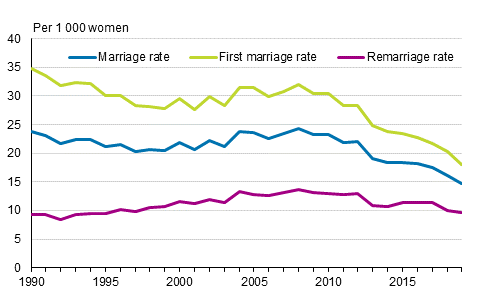
1. Married women per 1,000 non-married women and women not in a registered partnership of respective mean population aged 15 and over.
2. First marriages of women per 1,000 single women of respective mean population aged 15 or over.
3. Remarried women per 1,000 previously married women of respective mean population.
The figure shows the development of the marriage rates for women as they are the same as for men. The figures calculated for men are higher than those for women except for those for the rate of first marriages, which are slightly lower than for women.
The decrease in the remarriage rate has been slightly more moderate in recent years compared to the rate of first marriages. While the rate of first marriages decreased by 22 per cent from 2015 to 2019, correspondingly, the remarriage rate decreased by 16 per cent.
The figure above shows that 2008 has been the peak year of marriages in the 2000s. It can be calculated that if the rate of first marriages in 2008 had remained prevailing, 70 per cent of unmarried men and 76 per cent of unmarried women would have been married before the age of 50. As already reported earlier, the corresponding numbers were considerably lower in 2019, which is also visible in the figure below.
The expected share of men and women entering into their first marriage before the age 50 by the marriage rates in 2008, 2012,2016 and 2019, opposite-sex couples
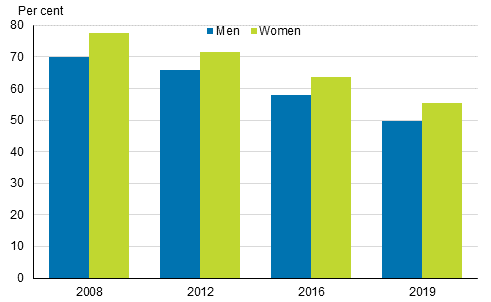
There is no age limit for entering into marriage, so it is also possible to assess the lifelong marriage rate on the basis of the marriage rate of different years. If the marriage rate of 2019 was prevailing, 54 per cent of unmarried men would get married in their lifetime and 59 per cent of women. In 2008, the respective figures were 73 per cent for unmarried men and 78 per cent for women. In older age groups, the marriage rate is low, which is visible in that the figures of the lifelong marriage rate are not significantly higher than the share of married persons before the 50th birthday.
It should be borne in mind that even though entering into marriage appears to have decreased, it does not mean that couple formation has decreased. Because cohabiting is not registered, it is not known how many of them are formed annually. The statistics on families only show the number of cohabiting couples at the end of the year. However, the fact that the number has been growing continuously indicates something. For example, the number of cohabiting couples of opposite sex was 263,000 in 2000, but by 2019 the number had grown to 347,000. Over the same period, the number of families of married couples where the spouses are of different sexes fell from 951,000 to 930,000.
The above-mentioned percentages of the expected marriage rate of unmarried persons have been produced by forming a marriage rate table based on the calculation principles of the life table . The calculation uses five-year age group-specific marriage rates for men and women that entered into their first marriage. Mortality is not taken into account in the calculation. It is, however, low before the age of 50, which is why the end result gives a good picture of the marriage rate.
Marriage rate decreased in all regions of Mainland Finland
In 2019, the highest relative numbers of marriages were recorded in Ostrobothnia and the lowest in North Karelia. The marriage rate shrunk most in relative terms in Satakunta, by 18 per cent.
Marriage rate¹ by region² and whole country in 2018 and in 2019, opposite-sex couples
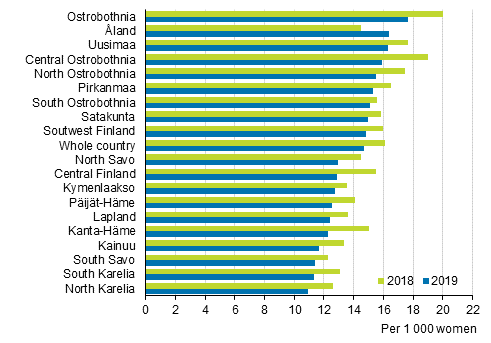
1. Married women per 1,000 non-married women and women not in a registered partnership of respective mean population.
2. Regional division 1.1.2020.
Clearly under one-half of marriages are church weddings
In all, 41 per cent of all marriages of opposite sex were church weddings in 2019. The share of church weddings in all marriages entered into decreased to under 50 per cent in 2012. The figures are based on marriages entered into, where either one or both spouses of opposite sex lived permanently in Finland at the time of the marriage.
Marriages contracted by type of wedding ceremony in 2006 to 2019, opposite-sex couples
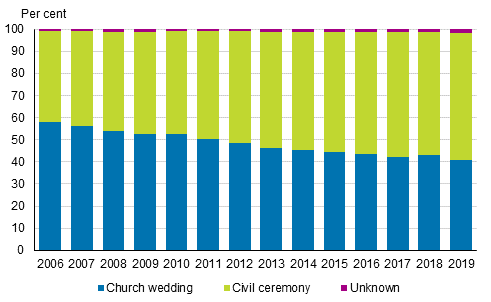
Slightly over 50 per cent of first marriages still entered into at church
Altogether 52 per cent of spouses of different sexes living in Finland who both entered into their first marriage were married at church in 2019. The percentage has gradually diminished, in 2006 it was still 70.
Persons having entered into their first marriage by type of wedding ceremony in 2006 to 2019, persons of opposite sexes living permanently in Finland
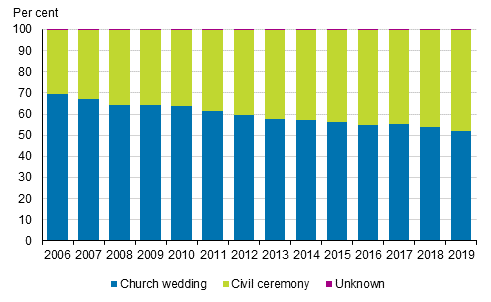
Changes in international marriages small
The decrease in the marriage rate in the whole country was also visible in the drop in international marriages from 1,547 to 1,386 from 2018 to 2019. In all, 6.8 per cent of women of Finnish background living permanently in Finland got married to a man of foreign background in 2019. One year earlier the share was a bit higher, 7.0 per cent. In general, the share of international marriages of all marriages entered into by women of Finnish background has, however, increased gradually. In 1990 to 2000, the above-mentioned share was around four to five per cent.
The share of marriages between men of Finnish background living permanently in Finland and women of foreign background among all marriages entered into grew to 7.0 per cent in 2019 from 5.9 per cent in the previous year. The number of marriages of the type mentioned above grew from 1,308 to 1,449.
There are more data on marriages and divorces between Finnish and foreign citizens on the Immigrants and integration thematic pages .
Nearly four in ten first marriages still end in divorce
In 2019, the probability that a woman’s first marriage ends in divorce was 38 per cent, which is one percentage point higher than in 2018. However, the figure for 2019 was on level with that for 2005 to 2017, when it varied between 38 and 40 per cent. An interesting fact is that a first marriage ending in widowhood is slightly more probable than the marriage ending in divorce. The above-mentioned probabilities are based on the events of one year of opposite-sex married couples based on which the probability that an event takes place is calculated. In that case, e.g. the divorce rate can be summarised in one figure. Similar results can be reached by examining marriages of opposite-sex couples entered into in a particular year that end in divorce by the duration of the marriage, but in this case, there are as many divorce rates as years in which the examined marriages are entered into.
The overall picture is that since the 1990s, the divorce rates by the duration of marriage are very similar and are thus not dependent on the year in which the marriage was entered into. For example, of the marriages entered into in 1990 to 2010, one-fifth had ended in divorce by the ninth year.
However, in recent years there has been some indication that the divorce rate during the early years of marriage might be decreasing slightly. For example, 4.7 per cent of the marriages entered into in 2014 ended in divorce in the third year of marriage, while the share for marriages entered into in 2016 was 4.0 per cent and that for marriages in 2017 was 3.7 per cent. Correspondingly, 1.7 per cent of marriages entered into in 2014 ended in divorce in the second year of marriage, 1.3 per cent of marriages entered into in 2017 and 1.2 per cent of those in 2018. This change of 0.5 percentage points seems small but in the case of small figures the change is relatively big, 29 per cent.
Divorce rates cumulated for women entering into marriage in certain years by the end of 2019, opposite-sex couples
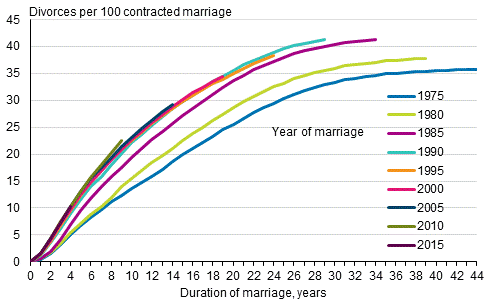
For a long time, the share of divorces was highest among those who had entered into marriages in 1985 until by 2017 a slightly higher share of marriages entered into in 1989 had ended in divorce. The order has not changed during 2019. By the end of 2019, in total 42.1 per cent of marriages entered into in 1989 had ended in divorce. By contrast, the share of divorces from marriages entered into in 1988, 41.5 per cent, has climbed one decimal higher up than the share of divorces in marriages entered into in 1985. The percentage of divorces of 40 per cent is also reached by persons having entered into marriage in years close to the above-mentioned years: 1982 to 1984, 1986 to 1987 and 1990 to 1993. If the divorce rate remains at the level where it has been for a long time, it is highly possible that the other marriage cohorts of the 1980s and the 1990s will reach the same divorce rate level as those who entered into marriage in 1985 and 1989.
Risk of divorce grows strongly in the first years of marriage
The risk of divorce grows steeply during the first years of marriage, as the following figure shows. The risk has been at its highest in the third or fourth year when the divorce rate in different years of marriage has been examined starting from 1990. After the peak for divorcing is reached, the risk of divorce decreases very similarly in all marriage cohorts. The figure shows the above-mentioned recent development, based on which the risk of divorce has slightly contracted in the early years of marriage when comparing 2015 and 2017. Coming years will show, whether this contraction is merely random variation.
Divorces by year entering into marriage and duration of marriage, women, opposite-sex couples
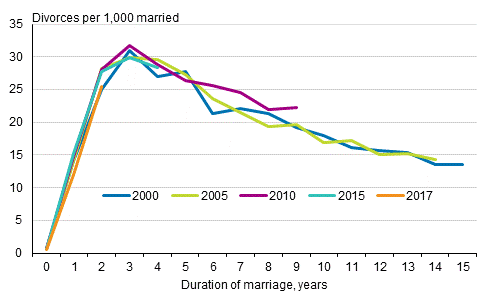
Same-sex persons entered into almost as many marriages as in the previous year
In 2019, the number of marriages entered into by same-sex persons decreased to 376 from the previous year's 387. The strong decline in 2018 after the legislative amendment of 2017 did not continue in 2019. However, the fall in the number continued for male couples, but this was compensated by the growing number of marriages entered into by female couples compared with the previous year.
Since 2006, women have registered more partnerships than men per year. This has not changed when same-sex couples started entering into marriages instead of registered partnerships in 2017. In some years, the number of new official female couples has been double compared to male couples.
Registered partnerships 2002–2016 and registered partnerships and contracted same-sex marriages 2017¹–2019
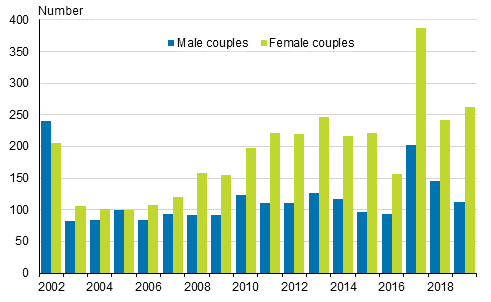
1. Year 2017 includes both registered partnerships and contracted marriages. From the year 2018 on contracted marriages
The average age of the older spouse of a male couple is clearly higher than that of a spouse of a female couple.
When examining same-sex couples entering into their first registered partnership or marriage, the average age of the older spouse of male couples has always been clearly higher than that of the older spouse of female couples: the difference in average ages was smallest in 2006. In 2019, the average age of the older spouse of male couples who entered into their first marriage was 44 years and that of female couples 36 years. Correspondingly, the average age of the younger spouse of male couples was 37 in 2019, while for the younger spouse of female couples it was 32.
During the whole reference period starting from 2002, the average ages of female couples entering into their first registered partnership or first marriage show a slight downward trend. In other words, the spouses of female couples entering into their first marriage are slightly younger than before. This cannot be seen for male couples.
The trend in the average ages of same-sex spouses entering into their first marriage does not show the direction of the average of opposite-sex spouses. The average ages of opposite-sex spouses entering into their first marriage have been growing for a long time, for example, the average age of wives .
Average age of men and women when registering their first partnership in 2002 to 2016 and when entering into their first marriage in 2017 to 2019, same-sex couples
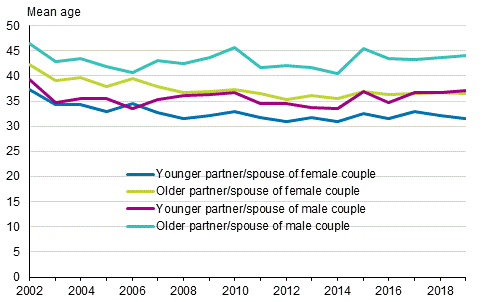
Divorce rate among same-sex couples still declining
The divorce rate of same-sex couples has been decreasing continuously since 2015. In the last few years, the divorce rate has decreased more steeply than before. By contrast, the divorce rate of opposite sexes has remained almost unchanged.
In 2019, the change in the divorce rate was small for couples of opposite sexes compared with the previous year, unlike for same-sex couples. The divorce rate of same-sex couples decreased by 10 per cent, two percentage points more than in the year before. The divorce rate of same-sex couples was 18 per one thousand couples, in the year before it was 20. The corresponding divorce rate for opposite-sex couples remained unchanged at 13 per one thousand couples.
There has been a clear difference in the divorce rates of male and female couples as female couples’ divorces have been clearly more common than those of male couples since 2004. In 2019, the divorce rate of both female and male couples decreased, but the divorce rate of female couples much more than that of male couples. For this reason, the divorce rate of same-sex couples decreased much more strongly than in the previous year.
Divorce rates from registered partnerships¹ and marriages 2003–2019
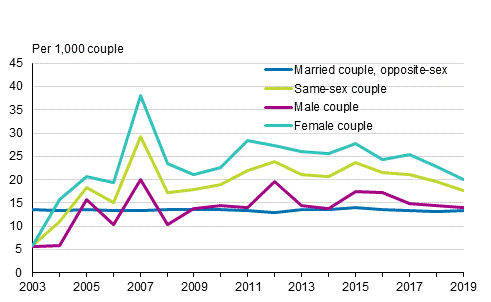
1. Divorces from registered partnerships 2003–2019. From the year 2017 on also includes divorces from same-sex marriages.
Source: Changes in marital status 2019. Statistics Finland
Inquiries: Timo Nikander 029 551 3250, info@stat.fi
Head of Department in charge: Hannele Orjala
Publication in pdf-format (352.5 kB)
- Tables
-
Tables in databases
Pick the data you need into tables, view the data as graphs, or download the data for your use.
Appendix tables
- Quality descriptions
-
- Quality description, changes in marital status (12.11.2020)
Updated 12.11.2020
Official Statistics of Finland (OSF):
Changes in marital status [e-publication].
ISSN=1797-643X. 02 2019. Helsinki: Statistics Finland [referred: 24.12.2025].
Access method: http://stat.fi/til/ssaaty/2019/02/ssaaty_2019_02_2020-11-12_tie_001_en.html

